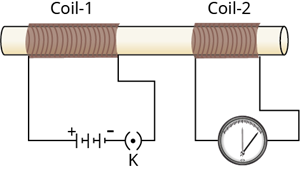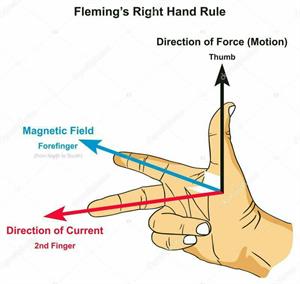
PUMPA - SMART LEARNING
எங்கள் ஆசிரியர்களுடன் 1-ஆன்-1 ஆலோசனை நேரத்தைப் பெறுங்கள். டாப்பர் ஆவதற்கு நாங்கள் பயிற்சி அளிப்போம்
Book Free DemoIn the previous section, we did an activity to observe the effects of a moving magnet in a fixed conductor.
Let us now perform a variation of previous activity in which a current-carrying coil replaces the moving magnet, and the current in the coil can be varied.
Let us now perform a variation of previous activity in which a current-carrying coil replaces the moving magnet, and the current in the coil can be varied.
Steps:
- Take two different coils of copper wire with a large number of turns (say 50 and 100 turns, respectively) and insert them over a non-conducting cylindrical roll, as shown in the below figure (You may use a thick paper roll).

Current is induced in coil-2 when current in coil-1 is changed.
- Connect the coil-1, which has a larger number of turns, in series with a battery and a plug key. Also, connect the other coil-2 with a galvanometer, as shown in the figure.
- Plug in the key. Notice the galvanometer.
- Is there a deflection in the galvanometer's needle?
You will see that the needle of the galvanometer immediately jumps to one side and just as quickly returns to zero, indicating a momentary current in coil-2.
- Disconnect coil-1 from the battery.
You will see that the needle momentarily moves but to the opposite side. It indicates that now the current flows in the opposite direction in coil-2.
Observations:
In this activity, we see that as soon as the current in coil-1 reaches either a steady value or zero, the galvanometer in coil-2 shows no deflection.
This activity shows that whenever the electric current through coil–1 changes (starting or stopping), the potential difference is induced in coil-2. Coil-1 and coil-2 are known as the primary and secondary coils, respectively. As the current in the first coil varies, then the corresponding magnetic field also changes. Thus, the magnetic field lines around the secondary coil (coil -2) also change.
Hence the change in magnetic field lines associated with the secondary coil is the cause of induced electric current in it. This is called Electromagnetic induction.
Electromagnetic induction:
The process in which a changing magnetic field in a conductor induces a current in another conductor is called Electromagnetic induction.
In practice, we can induce a current in a coil by moving it in a magnetic field or changing the magnetic field around it. In most situations, it is easy to move the coil in a magnetic field.
The induced current is observed to be the highest when the direction of motion of the coil is at right angles to the magnetic field.
In this situation, we can use a simple rule to know the direction of the induced current.
Stretch the right hand's thumb, forefinger, and middle finger perpendicular to each other, as shown in the below figure. Suppose the forefinger indicates the direction of the magnetic field, and the thumb shows the direction of motion of the conductor. In that case, the middle finger will show the direction of the induced current. This simple rule is called Fleming's right-hand rule.

Fleming's right-hand rule